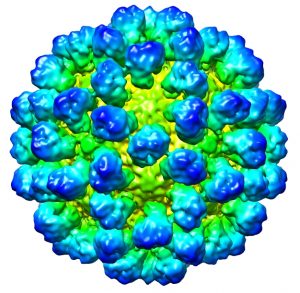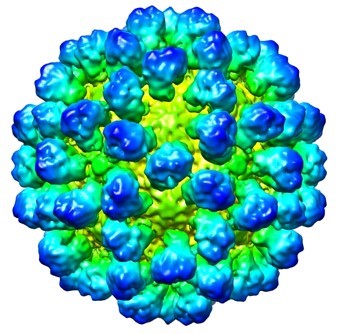
RHDV virion. Image by: A2-33 Wikimedia Commons
Contributed by: Dr. Brian Cooke (Feb, 2021)
One interesting aspect of the new coronavirus disease (Covid-19) is that the causal virus (SARS-Cov2) rarely affects children. And even if infected, kids rarely show acute symptoms like those seen in elderly patients.
This is often passed off by saying that children have much better immune systems than older immuno-compromised adults. While this is true, there are also ‘childhood diseases’ such as measles and chicken pox which, before vaccines were developed, predominantly affect school-age children – so is the picture really that simple?
Interestingly, rabbit haemorrhagic disease virus (RHDV – pictured above), introduced into Australia 25 years ago to control pest rabbits, also spread poorly among young rabbits and caused no overt disease, but once rabbits became 12-week-old ‘sub-adults’, they became highly susceptible and up to 95% died if infected. By contrast, the myxoma virus, another pathogen released to control rabbits, generally caused heavier mortality among rabbit kittens than adults.
It seems from such observations that there must be two-way interaction between viruses and hosts’ immune systems. Age-related outcomes might be partly determined by the virus, not just the host. If this is the case, how could a simple virus ‘choose’ to infect hosts of a certain age? Moreover, how could such a system have evolved?
Although some scientists think that RHDV ‘jumped’ into rabbits from another species, it is generally considered that it evolved from closely related non-pathogenic caliciviruses which still circulate harmlessly in wild and domestic rabbits. These viruses are passed from rabbit to rabbit by social contact (Capucci et al 1996). However, the rabbit’s social world differs from ours, especially during the rabbit’s breeding season. When breeding, wild rabbits form tight social groups, often 2 – 3 adult females and 1 – 2 males and they defend a territory around their home warren, fighting and chasing off other rabbits which try to intrude. Young rabbits have little social contact with rabbits outside their group because they do not stray from the warren.
On the other hand, adult male rabbits make forays to the edge of their territory, not only to chase away other rabbits but also to reinforce their territorial boundaries using scent from their chin glands or to deposit strongly scented droppings on dung-hills or ‘buck-heaps’ to claim ownership. Chin gland secretions of dominant male rabbits are not only used to cover scent marks of other visiting males but also applied to female rabbits and young to maintain a group smell and enhance recognition of group members (Mykytowycz 1969).
It is not hard to see the advantage for a virus if it affected sub-adult or adult rabbits under those circumstances. It could spread from one rabbit territory to another much more readily. That would be especially so when sub-adult rabbits left their home warren and tried to attach themselves to a new social group (Jennings and Mutze 2017). By contrast, a virus which affected mainly young rabbit kittens would be confined within a social group and its chances of spread and persistence would be reduced.
It is harder to see how a simple virus could preferentially infect an adult rabbit rather than a young one. Nonetheless, there are possible mechanisms. We know, for instance, that cortico-steroids produced by the adrenal glands change during growth and development of the young rabbit and that adrenal glands take on their final adult shape only when rabbits reach 12-weeks of age.
Thus, it is conceivable that those non-pathogenic caliciviruses which most readily infect rabbits with ‘mature’ adrenals and the right mix of cortico-steroid hormones might have had a selective advantage because they spread more easily between rabbit territories. Sex hormones can be excluded in this case because non-pathogenic caliciviruses infect both sexes equally.
Although a non-pathogenic precursor of RHDV may have been adapted to spread between rabbits in this way, things changed when highly virulent RHDV emerged. Instead of rabbit to rabbit spread alone, it could suddenly be transmitted by insects such as carrion flies that feed on dead rabbits (Asgari et al 1998) then leave ‘fly-spots’ containing viable virus on pasture vegetation subsequently eaten by rabbits.
Under those circumstances it may not have been so important for the virus to infect mostly adult rabbits and indeed, there is evidence from the field that as the years progressed an increasing number of young rabbits that died from RHD were found (Mutze et al). It may also be relevant that RHDV2, a new virus variant that is displacing RHDV, spreads with greater facility among young rabbits (Dalton et al).
These details can be summarized by saying that when RHDV first emerged, it still retained some of the characteristics of its non-pathogenic ancestor, but since that time, with evolutionary changes, viruses are losing some of those characteristics as they evolve.
Perhaps this also says something about Covid-19. If it has recently emerged from a wildlife reservoir or from a related virus of low pathogenicity, we might expect it to retain some of the characteristics of the antecedent virus, such as a low rate of infection among juveniles. Nonetheless, these characteristics could diminish over time if they do not help the virus to spread efficiently among humans.
We should be on the lookout for the possibility that as Covid-19 evolves, it may behave differently and begin to infect a wider cross-section of the population including younger age groups.
Dr. Brian Cooke.
References
Asgari, S., Hardy, J.R.E., Sinclair, R.G. and Cooke, B. (1998). Filed evidence for the mechanical transmission of rabbit haemorrhagic disease virus (RHDV) on flies (Diptera: Calliphoridae) among wild rabbits in Australia. Virus Research, 54, 123-132.
Capucci, L., Fusi, P., Lavazza, A., Pacciarini, M.L. and Rossi, C. (1996). Detection and preliminary characterization of a new calicivirus related to rabbit haemorrhagic disease but non-pathogenic. Journal of Virology, 70, 8614-8623.
Dalton, K., Nicieza, I., Balseiro, A. et al (2012). Variant Rabbit Hemorrhagic Disease Virus in Young Rabbits, Spain. Emerging Infectious Diseases. 18, 2009-2012.
Jennings, S. and Mutze, G. (2017). Multiple warren use by subadult wild rabbits, Oryctolagus cuniculus, and its implications for disease transmission. Wildlife Research 44, 582-586.
Mutze, G.J., Sinclair, R.G., Peacock, D.E. et al. (2014). Is increased juvenile infection the key to recovery of wild rabbit populations from the impact of rabbit haemorrhagic disease?. European Journal of Wildlife Research 60, 489–499.
Mykytowycz, R. and Gambale, A. (1969) The distribution of dung hills and the behaviour of free-living wild rabbits, Oryctolagus cuniculus (L.) upon them. Forma et Functio, 1, 333-349.
RHDV Image: A2-33 Wikimedia Commons. CC By-SA 3.0


With young children now being vulnerable to Covid19 it looks like these speculations were unfortunately right.
Now we just have to hope that, like many viruses, it also gets less deadly over time. RHDV has stayed generally very deadly because it now spreads substantially by flies visiting carcasses, but since we humans take care of our dead Covid has no such incentive. In time hopefully it will indeed be ‘just another cold’